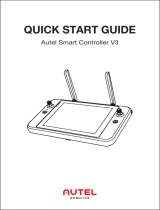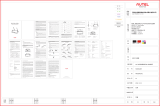
14
Aircraft
RF Exposure Information
This equipment complies with RF radiation exposure limits set forth for
an uncontrolled environment. This equipment should be operated with
minimum distance 20cm between the radiator and your body.
Remote Controller
FCC Specific Absorption Rate (SAR) information
SAR tests are conducted using standard operating positions accepted by
the FCC with the device transmitting at its highest certified power level in
all tested frequency bands, although the SAR is determined at the highest
certified power level, the actual SAR level of the device while operating
can be well below the maximum value, in general, the closer you are to a
wireless base station antenna, the lower the power output. Before a new
model device is an available for sale to the public, it must be tested and
certified to the FCC that it does not exceed the exposure limit established
by the FCC, Tests for each device are performed in positions and locations
(e.g. at the ear and worn on the body) as required by the FCC.
For limb worn operation, this device has been tested and meets the FCC
RF exposure guidelines when used with an accessory designated for this
product or when used with an accessory that contains no metal.
For body worn operation, this device has been tested and meets the FCC
RF exposure guidelines when used with an accessory designated for this
product or when used with an accessory that contains no metal and that
positions the device a minimum of 10mm from the body.
ISED Specific Absorption Rate (SAR) information
SAR tests are conducted using standard operating positions accepted
by the ISEDC with the device transmitting at its highest certified power
level in all tested frequency bands, although the SAR is determined at
the highest certified power level, the actual SAR level of the device while
operating can be well below the maximum value, in general, the closer
you are to a wireless base station antenna, the lower the power output.
Before a new model device is an available for sale to the public, it must
be tested and certified to the ISEDC that it does not exceed the exposure
limit established by the ISEDC, Tests for each device are performed in
positions and locations (e.g. at the ear and worn on the body)as required
by the ISEDC.
For limb worn operation, this device has been tested and meets the
ISEDCRF exposure guidelines when used with an accessory designated for
this product or when used with an accessory that contains no metal.






















